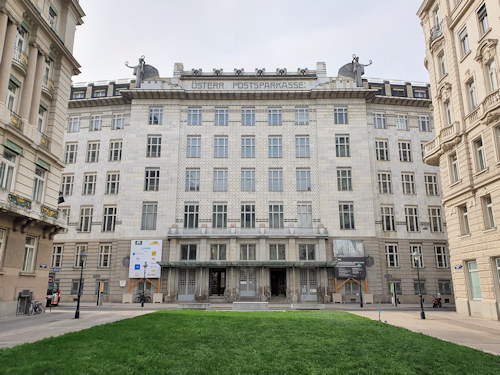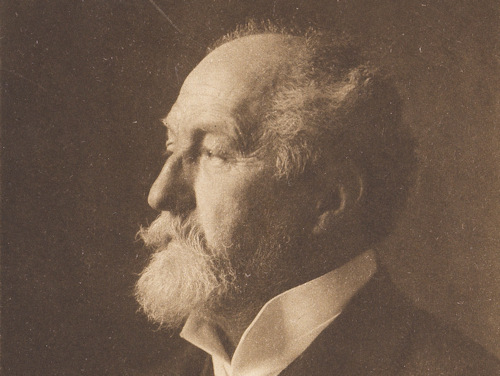
In a city of monumental historical buildings, one of the more important may actually be one of the lesser known. The WAGNER:WERK museum presents the early story of the Postsparkasse, but particularly its groundbreaking 1906 home in Vienna.
- Special focus on the architectural competition & Otto Wagner’s winning design
- Offers insight into early 20th-century Viennese life
- Broadens your understanding of Viennese Modernism
- Texts in English & German
- See also:
The PSK, Wagner & competitors

(The PSK building main entrance)
The former premises of the Postsparkasse postal savings bank represent perhaps one of the most important works designed by architect Otto Wagner.
The building makes a remarkable impression, especially when you consider the construction era (early 1900s).
And, unlike most Wagner designs, you can actually go inside this one and view what is now a home for various academic institutions.
After admiring the Große Kassenhalle (public counter space), pop into the smaller Kleine Kassenhalle for a bonus treat: the WAGNER:WERK museum.

(Portrait of Otto Wagner, the architect behind the Postsparkasse building; photo formerly owned by Rudolf Weiss and taken in 1911 by Wenzel Weis; Wien Museum Inv.-Nr. 208807; excerpt reproduced with permission under the terms of the CC0 licence)
This small public museum focuses on various historical aspects of the building, notably:
- The origin story of the Postsparkasse institution, its function, and early history
- The architectural competition and its role in driving a more modern approach, including the coincidental confluence of needs that led to a pioneering focus on function over style
- Wagner’s design and the jury response (same for some of the rejected competitor entries)
A giant model of the building, photos, blueprints, Wagner’s submissions, and other archival material illustrate the text-heavy presentation.
The result brings a little-known past to life, offering insights into the reality of the times: financial and economic pressures, worker conditions, public planning priorities, and similar.

(Front doors to the main building)
All of which may not sound quite so exciting as learning of royal machinations or admiring masterpieces crafted from oils and watercolours.
However, the story adds real depth to that important era in Viennese history, when Austria slipped into the modern age through an upsurge of creativity.
As such, the display helps you understand the concept of Viennese Modernism in a less abstract way: moving beyond famous names and displays of design items to round out the reality of the times at the ground level. (And what unusual times they must have been.)
The explanations also allow you to properly understand the progressive, groundbreaking nature of Wagner’s approach.
And, as an added bonus, you also get up close to the (original?) metal, glass, and marble counters that likely once filled the room.
Tickets and visitor tips
At the time of writing, entrance was free. When I last checked, the museum opened weekday afternoons but visitor details are difficult to find online (the museum had no counter or personnel on my visit; you just walked in).
If visiting, grab a coffee from the self-service café in the big Kassenhalle and immerse yourself in the turn-of-the-century architectural atmosphere.
Then, once you’re done in the Postsparkasse, consider the nearby MAK museum, which covers design and includes a section on Vienna Modernism where you can usually find pieces by Wagner.
(If at the MAK, you might nip over the road for some refreshment at one of my favourite coffee house haunts: Café Prückel.)
Other buildings near the Postsparkasse include highlights from the Jugendstil era, notably those on Fleischmarkt.
(And, if on Fleischmarkt, try the Diglas coffee house: another café we like to go to. Be sure to go through to the seating at the very rear.)
Finally, for a wider journey through Wagner’s Vienna, browse this list of locations. They cover buildings and infrastructure he designed as well as places of biographical interest like his grave.
How to get there
Check the travel tips for the main Postsparkasse building article. Go through the main entrance, up the stairs and into the large Kassenhalle hall. At the far left corner you’ll see an exit. Go through, beyond the door and across the corridor to reach the open display rooms.
Address: Georg-Coch-Platz 2, 1010 Vienna | Website